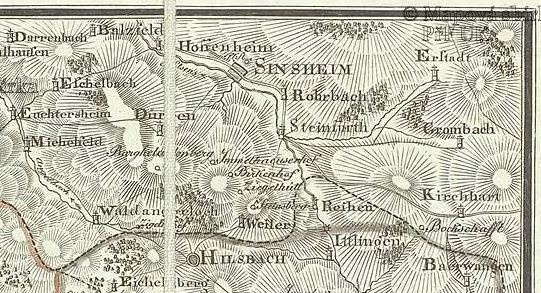
1813 Map showing Sinsheim, Immelhäuserhof, and Hilsbach, Germany [3]
1690 Peter Good may have been born about this time in Germany, perhaps near Sinsheim. [1]
Peter Good's father may have been Peter Gut, a member of the Mennonite Congregation of Immelhäuserhof, Germany, which is shown between Sinsheim and Hilsbach on this 1813 map. [2]

Based on his will and other sources, Peter Good had 4 wives and 8 children [4] [5]:
1727 Peter Good left Germany, perhaps from around Sinsheim, and arrived in Philadelphia, Pennsylvania on September 28, on the ship Molly from Rotterdam, via Deal and London.
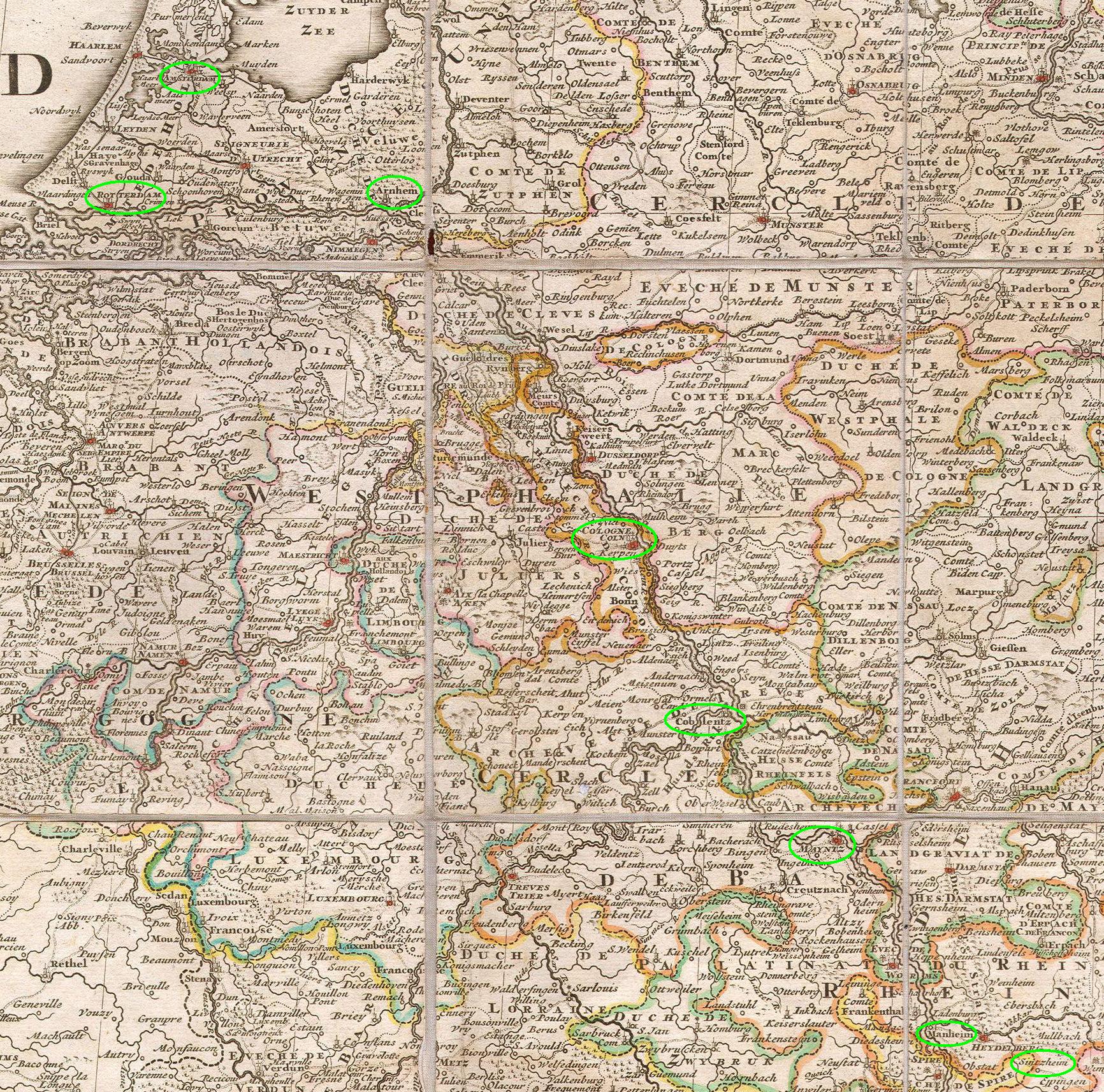
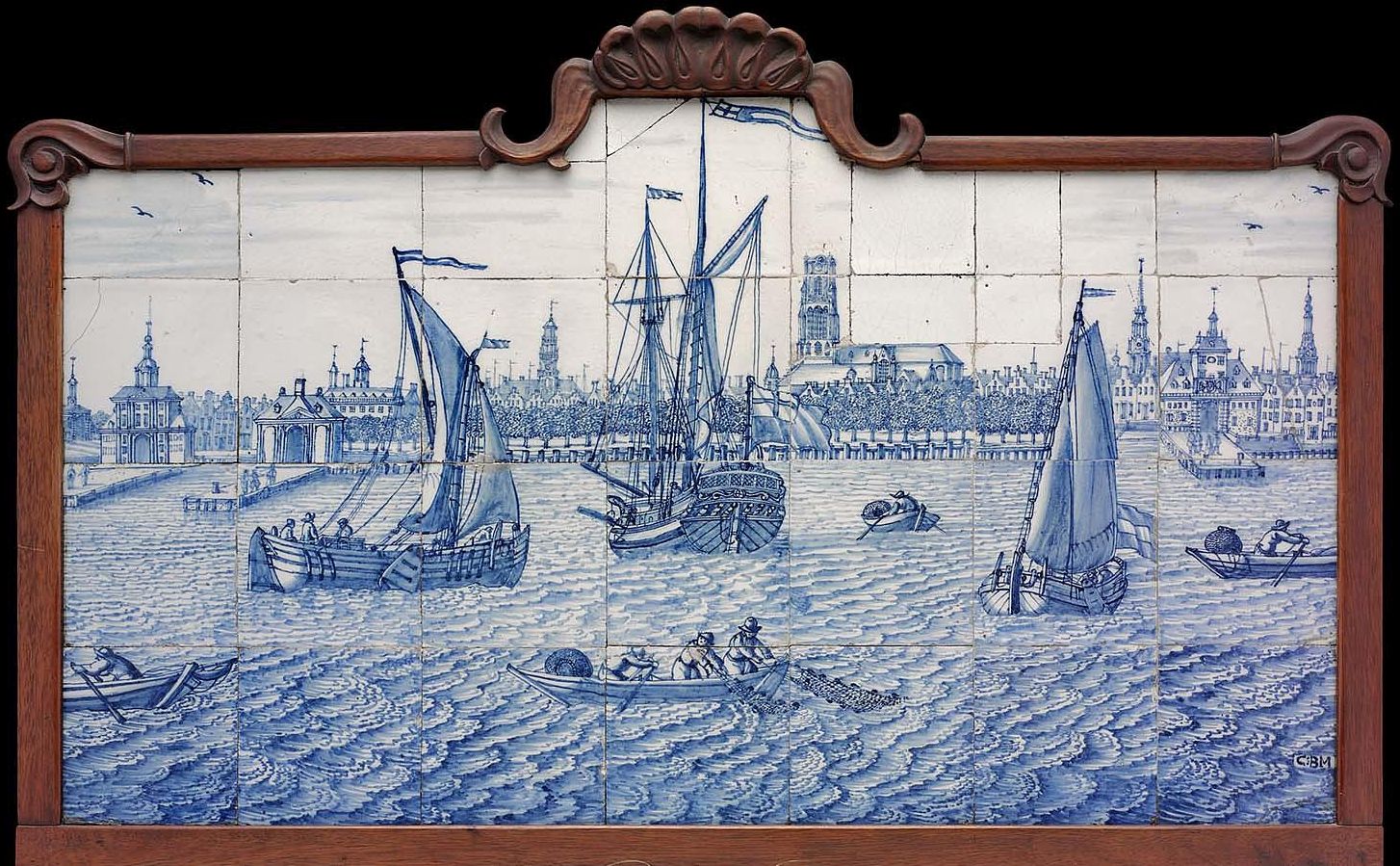
1727 The ship Molly cleared English customs in Deal, England and sailed for Philadelphia on July 14 with 72 heads of families and 300 persons on board. [13]

1727 Peter Good arrived in Philadelphia, Pennsylvania on the ship Molly on September 28.

1727 Peter Good's name was recorded on the ship list as Petter Good on one list [list 3A] [15] [16], and as Peder Gut on another list [list 3B] [17] [18] [19]. The passengers were qualified on September 30.
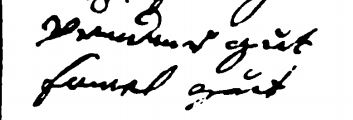
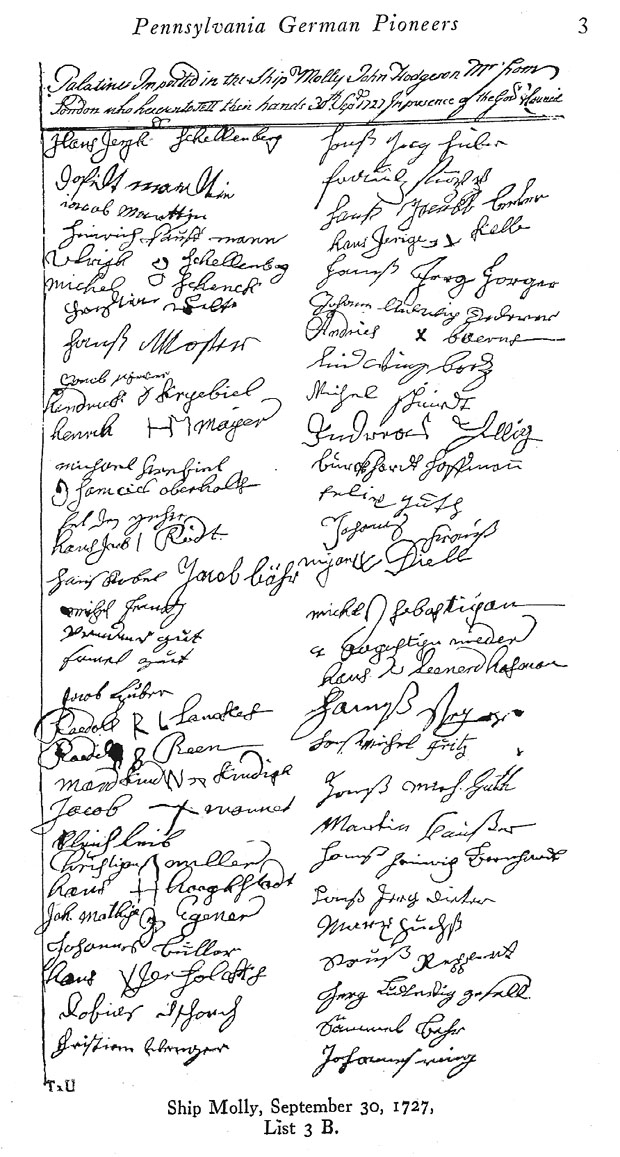
Don Good displayed the signatures of Peter Good from the 1727 immigration list, the 1728 naturalization, and the 1753 will, which appear to be similar signatures made by the same person. [20]
1728 Peder Gut signed the oath of allegiance to King George of England to be naturalized in Pennsylvania, which allowed him to hold land as a citizen. He was on the list of Mennonites. [21] [22] This was the result of efforts by Wendall Bowman [23] and Martin Mylen to pass legislation in Pennsylvania allowing land ownership by German Mennonite immigrants. Peter likely signed the oath at the courthouse pictured below.


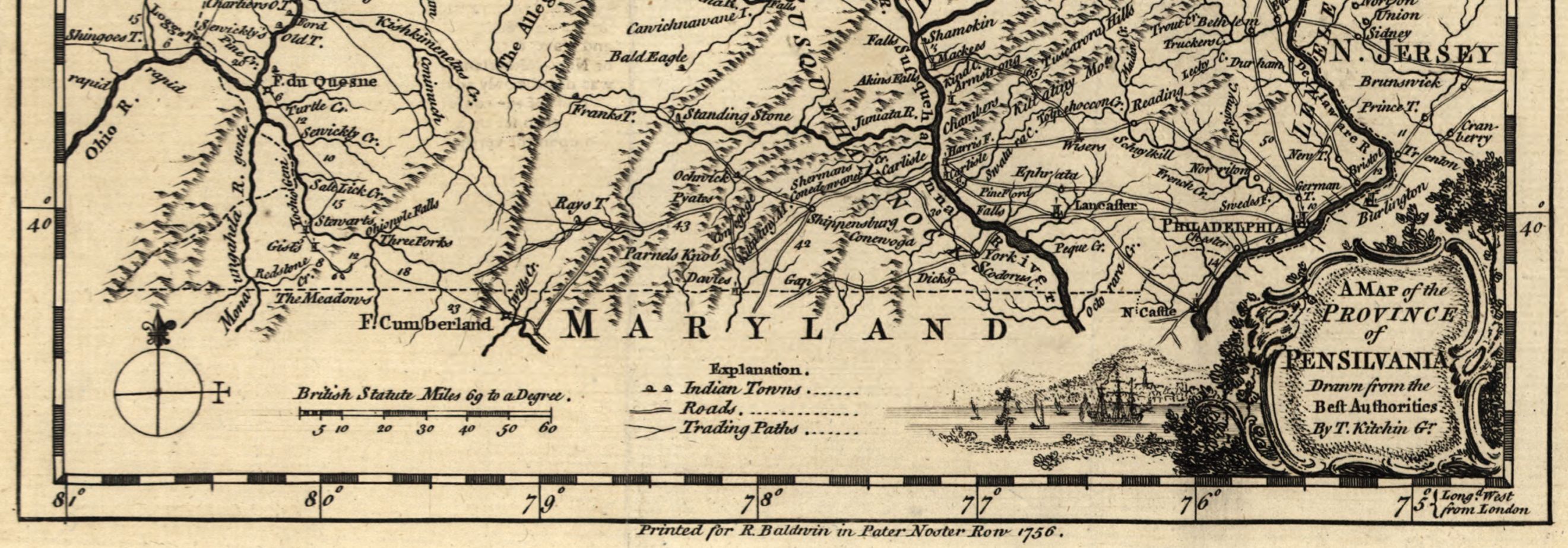
1735 Peter Gut received a warrant for 100 acres of land in Earl Twp, Lancaster County, Pennsylvania, dated October 23, but he did not purchase the land. [27] A patent for the land, dated November 5, 1738, was granted to Peter Gut's brother-in-law Peter Graff. [28] [29] Adjacent land was owned by Henry Bear [30], Leon Blaireaux [31], Philip Sheiffer, and Hans Graff [32]. Hans Good had land nearby [33].
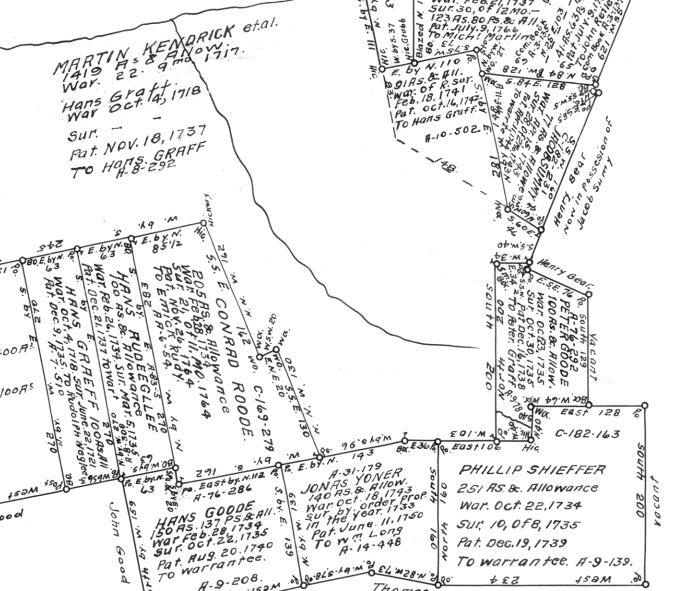
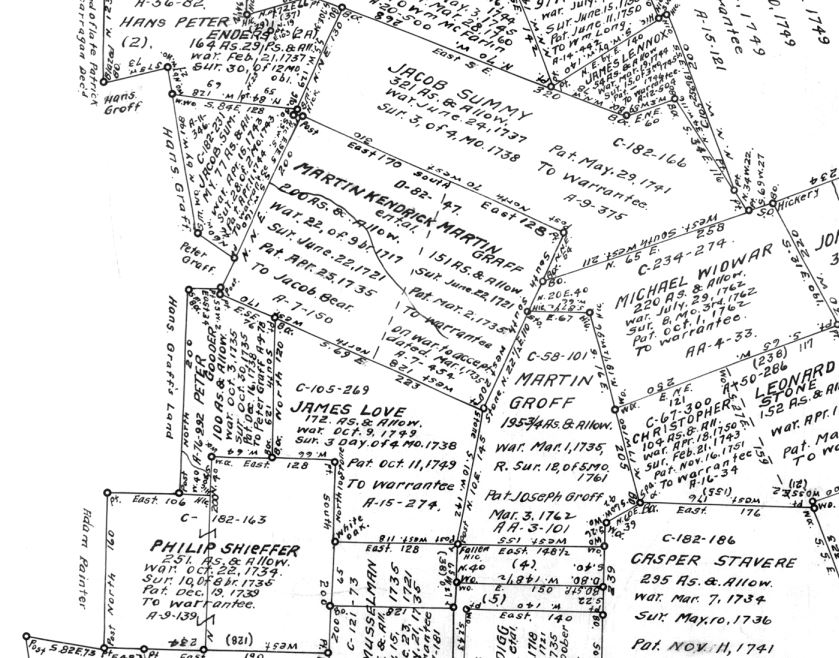
Whereas in pursuant and by vertue of our Warrant under the Lesser Seal of our province bearing Date the twenty third day of October in the Year of our Lord 1735 there was surveyed and laid out on the thirtieth day of the same Month unto Peter Goode of the County of Lancaster a certain tract of Land situate in Erle Township in the said County … and whereas the said Peter Goode by Indenture bearing date the twentyninth day of April in the year of our Lord 1737 for the consideration therein mentioned did grant bargain and sell unto Peter Graff of the said County the said described Tract of Land … [36]
1738 Neighbors Hans and Susanna Graff sold land to their well-beloved son Peter Graff in Earl Twp, Lancaster County on July 20. Peter Good owned land adjacent to the tract. [37]
… above described piece situate in Earltown afors'd beginning at a post in the line of the land of Hans Graff's … to a post then by the land of Henry Bear … (by land of Peter Good) … to the place beginning.
A letter from Tobias Bowman to Isaiah Reed Good, dated 1902, recounts the history of two of Peter and Margaret's sons. [38]. Here is the part about Jacob. The part about son Christian is given in the notes for Christian Good.
January 2nd 1902. Bowmansville Lancaster county Pa. Isaiah R. Good. My Dear friend: Your kind and welcome letter dated August 27th last duly received, I am very thankful for its contents, perhaps I made you wait too long for the information you asked for, well I will now try to give you the best records of the Good family that I could obtain.
First I will give you what your late Uncle John B. Good Esq of Lancaster city wrote for The History of Lancaster County, Pennsylvania. Published in 1883. He says "The first settlements seem to have been made in the valleys of the Black Muddy creek and that branch on which Good's mill was erected. The earliest Warrants issued out of the landoffice bear date in 1737 from one to two miles further north, on another branch of Muddy creek, near the site of the present village of Bowmansville, Jacob Good and Christian Good, two brothers, with their brother-in-law John Musselman, with their respective families, settled about the same time. These emigrants were Mennonites from the Palatinate. As the adjoining township of Earl and the valley of the conestoga in general had been settled at an earlier period principally by emigrants from the same counry and of like religious faiith, they received considerable friendly assistance from that quarter. Jacob Good, arriving at the spot chosen for the erection of his new home, on the right bank of the stream, a short distance below the confluence of the two forks of the middle branch of Muddy creek, about a mile below Bowmansville, took lodging under the inviting shelter of a patriarchal white-oak tree, where he deposited such household goods as he had brought along with him, and, with the assistance of his friends the Zimmermans from Earl, commenced the erection of such a house as the times and circumstances would permit. He at once purchased the ground on which he had settled with his family. The deed, which is from John Penn, is dated in 1738, and embraced a tract of six hundred and twenty-eight acres and the usual allowance. The country was a wilderness one vast forest, inhabited by wild beasts and Indians. As yet there were no roads, no houses, gardens, fields, or orchards. Jacob Good had but two children, both sons, named respectively Peter and Jacob. He divided the ample paternal domain equally between them. Peter with his family afterwards removed to Cumberland county. The younger Jacob was twice married, and had five sons and one daughter with his first and four sons and one daughter with his second wife. With his last wife and her children he emigrated to Virginia. His descendants by his first wife are still residing in the neighborhood, some of them on part of the original tract.
1737 The will of Melchior Brenneman was proved on April 2, 1737, in Lancaster County. The will was written in High German and was witnessed by Hans Caige and Peter Gutt. [39]
1744 Peter Good, of Lancaster County, was naturalized, on April 10-12, at the court in Philadelphia, Pennsylvania. [40]
1748 'Brother' Hantsch, a Moravian missionary, visited several families in Pennsylvania, including Christian and Jacob Good (perhaps sons of Peter). His diary gave the following account of the visit. [41]:
We Ride Out to Muddy Creek …
Monday, July 11, 1748: We made our way to Michael Rang's. On the way we visited first Jacob Oberholtzer, a Mennonite. We found him mowing in the field. He showed himself friendly toward us. We were able to speak quite reasonably with him. He said too, that he had no objection to our visit, but that he liked it.
Visited next Johannes Muselman, also a Mennonite, who was just as friendly toward us. They gave us dinner. We also had an opportunity to say something of our Dear Savior, but we noticed that it was a foreign language to them.
No arguments Today!
Christian Guth's was our next stop. He is a preacher, who was quite friendly to us, and quite satisfied with us over the conversation we had on the Dear Savior. Toward the end he wanted to begin on Infant Baptism, but because we did not want to become involved in this discourse, we made it as short as we could. He directed us to his brother, Jacob Guth, who however was not at home. His wife came in at once from the fields. She was friendly to us, but we left again shortly.
A biosketch of wife Hanna Groff reports [42]:
Hanna (Anna) Groff was the wife of Peter Good on 30 July, 1746, and was listed among the heirs of Hans Groff. They had been advanced her share before that date. Peter Good had warranted on 23 October, 1735, 100 acres adjacent to the 1419 acres of Hans Groff (E). Peter Good's tract was surveyed 30 October, 1735, and was patented on 16 December, 1738 to Peter Groff (E2), a month after the date of Hans Groffs will.[43] [44]
Peter Good qualified at Philadelphia on the ship Molly on 30 September, 1727, and he must have married Hannah Groff as his third wife shortly after that date. He dated his will in 1753 and names Fronica Hiestand as his fourth wife, and Henry as their child. The other three wives are not named, but the children of each are listed. Anna, Jacob, and Christian were children of the first wife, and they purchased land in Brecknock Township in 1737 and 1738. At least Anna and Jacob were on the ship Samuel, aged twenty years, and newly married, qualifying in Philadelphia on 11 August 1732 [45]. The second wife had children named Mary, who may have married Jacob Groff (A3), and Barbara. Hanna Groff was the mother of Susanna (E31) and Peter (E32) Good, who must have been at least twenty one years old on 23 December, 1754, when he was one of those who renounced rights of administration of his father's estate.
Hanna Groff died between 1746 and about 1750. Peter Good (E32) is probably the one listed as married to Christina Landis (E54), his first cousin [46]. Their mothers were sisters and died about the same time. There are no estate records for this Peter Good in Lancaster County.
1751 Petter Good was taxed in Rapho Twp, Lancaster County, Pennsylvania. [47] [48] In 1756 Peter Guthe alis was listed with 40 acres. Lodwick Metez was listed with 200 acres on the next page. [49] [50] In 1757 Peter Guthe alis was listed. [51] [52] 1758 Peter Good was taxed. [53] [54] [55] [56]
1754 The will of Peter Good was written in German and the German text is not recorded in Lancaster County will books (Lancaster Will book A-104) [57] [58] Images of the original will are shown below (from the website of Don Good).
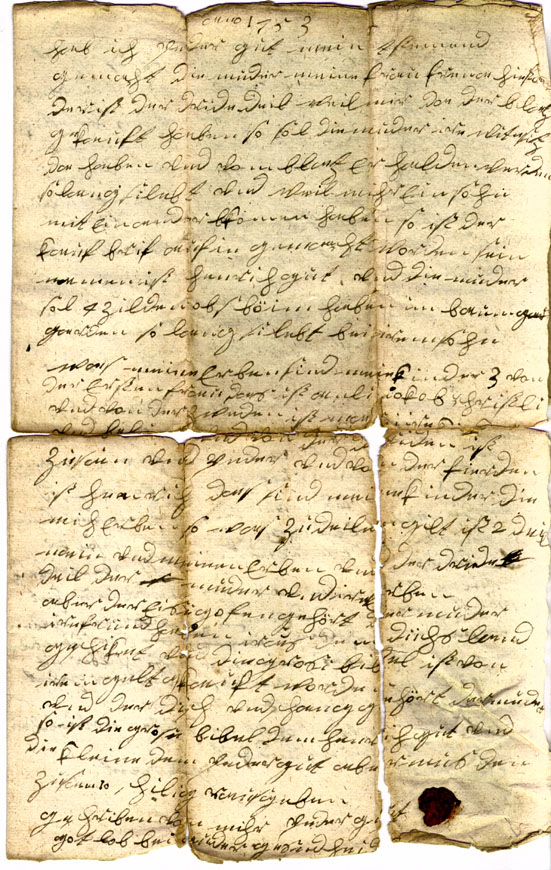
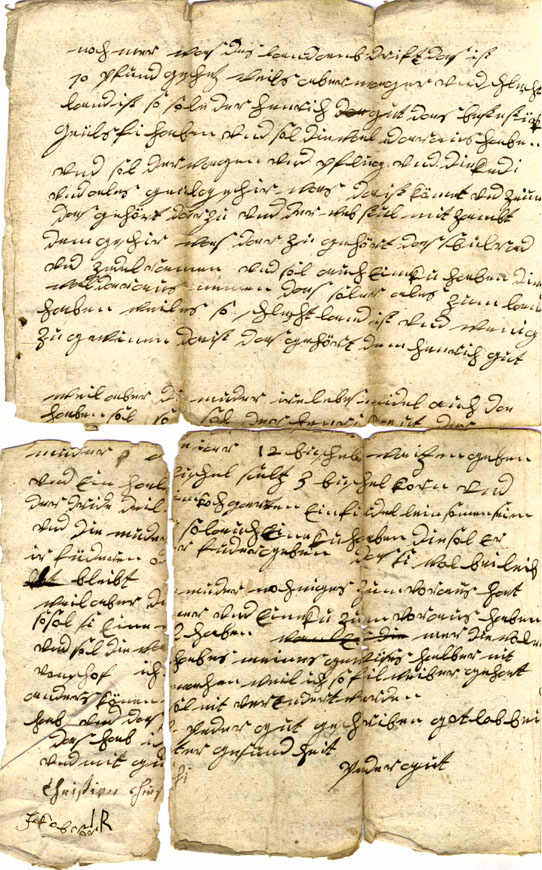
Amos B Hoover provided a transcription of the German, dated April 8, 2008.
Anno 1753
Hab ich Peder Gut mein Vemund gemacht, die mudder, meine Frau Frene Hiestand der ist der dride deil, weil mir da der Blatz gekauft haben, so sol die muder ire witesitz da haben. Und vom blatz erholden werden so lang si lebt. Und weil mihr ein sohn mit einander bekomen haben, so ist der Kauf Brif auch in gemacht worden. Sein nemen ist Henrich Gut. Und die muder sol 4 Zieden Obst böim haben im baum garden, so lang si lebt bei irem sohn.Was meine Erben sind mein kinder, der 3 von der Ersten frau: das is Aneli, Jakob u. Christli und von der zweden ist Nanse iire kinder und Bebi und von der driden ist Zusan und Peder. Und von der fierden ist Henrich, das sind meine kinder die mich erben, so was zu deilen gilt ist zwei deil mein, und meinen Erben, und der dride deil der muder und ir erben.
Aber der Eisig ofen gehört der muder ire freund[schaft] haben iras dem diehsland geschiket. Und die grosi Bibel ist von irein Gelt gekauft worden und der disch und schancg gehört der muder, so ist die grosse bibel dem Henrich Gut und die kleine dem Peder Gut, aber (er) mus den Zusanna 10 schilig raus geben.
geschrieben von mihr Peder Gut
God lob bei guder gesund heitNoch mer was des land anbedrift; das ist 70 Pfund geschetz. weils aber mager und schlecht land iss so sole der Henrich Gut das bestess geuls fi haben, und sol die wal daraus haben und sol der wagen und pflug und die kedi und ales geül geschir was da ist, kömet und zaum das gehört darzu, und der webstul mit zambt dem geschir was darzu gehört; das sbulrad [spulrad] und zedel ramen. Und sol auch Ein Ku haben, dim wal daraus nemen. das sol er ales Zum land haben weil es schlecht land ist und wenig zu gewinen da ist. Das gehört dem Henrich Gut.
Weil aber die muder ire lebesmidel auch da haben sol, so sol der Henrich Gut der muder 5 akier, 12 buschel weitzen geben und Ein Halb buschel saltz, 3 bushel Korn und der dride deil im Koch garten. Ein fiedel lein samen seiem und die muder sol euchne Ku haben, die sol er ir fuderen, der fuder geben das si wol bei leib bleibt.
Weil aber die muder noch juger zum voraus hat so sol si Eine mar und Eine ku zum voraus haben, und sol die wal haben. mer, die wolen von schof. ich habe meines gewises halber nit anders könen machen, weil ich so fil weiber gehat hab, und das sol nit verendert werden.
Das hab ich Peder Gut geschriben. Got lob bei und mit guten gesund heit.
Peter Gut
Christian Hershey
IR
Jacob Rorer
1754 The will was affirmed on December 23 by witnesses Christian Hershey & Jacob Rorer. The will named no executor. Letters of Administration were to be issued to Christian Baughman. [59]

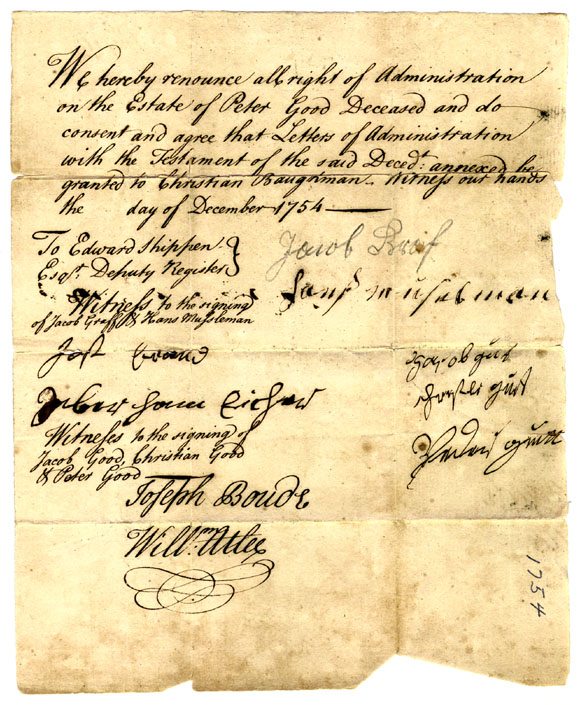
Several English translations have been made of the will. [Donald I. Good's Family History website. The website is no longer being maintained since his death in 2017]
A translation by Amos B. Hoover, dated April 8, 2008, differs from others by naming daughter Nancy instead of Mary.
In the year 1753, I Peter Good have made my will. The Mother, my wife Frany Hiestand is to have the third share, because we have bought the farm, therefore shall mother have her seat of widowhood here, and be supported by the farm as long as she lives. And since we had a son together, a sales agreement has also been made. His name is Henrich Good. And Mother shall have 4 different sorts of fruit trees in the orchard, as long as she lives with her son.
My heirs are my children: three from my first wife Aneli [or Anna], Jacob and Christian. And from my second wife are Nancy's children and Barbara, and from the third [wife] is Susan and Peter, and from the fourth is Henrich. These are my children that will inherit me, so what is to be fairly divided is: two parts to me and my heirs, and the third part to mother and her heirs.
But the iron stove belongs to Mother because her relatives sent it to this country. The large Bible was bought with her money. And the table and schrank belong to mother. Thus the large Bible belongs to Henrich Good and the small one to Peter Good but he must pay Susanna 10 shillings.
Written by me Peter Good.
Praise God while in good health.More details concerning the land. It is evaluated at 70 Pounds, but because it is unfertile and poor land so shall Henrich Good receive the best of the draft horses and he shall have choice of them. He shall have the wagon and plow and the chains and all that has to do with the horse harnesses including the collars and bridles and accessories, And the weaving loom and all the harnesses that belong to it and the warp and the warping mill and he shall also have a cow picking the choice one. This he shall all have in addition to the land, because the land is so poor and little profit can be made with it. This all belongs to Henrich Good.
But since mother is also to obtain her food from [the farm] Henrich Good shall provide 5 acre; 12 bushels of wheat and a half bushel of salt, 3 bushel of rye and a third part of the vegetable garden and a fourth of the linen seed meal. And Mother shall have her own cow. He shall supply feed and feed her that she maintains good body weight.
Since Mother is much younger, she shall in advance have a mare ahead of time and a cow and shall have her pick. Also [she shall have] the wool of sheep. For the sake of my conscience I could not make it any different, because I had so many wives. This [will] shall not be changed.
I Peter Good have written this in good health and praise God for the same.
Peter Good
[Witness:]
Christian Hershey
IR
Jacob Rorer


Copia) will Anno 1753
Have I Petter Good Made my last will & Teftament the Mother my wife Fronica Histand to her belonging the Third becaufe wee have Bought that place So the Mother Shall have for Widdowhood thereon and Shall be maintained out of the place her during Life, and as we have begat one Son together So is the Tittle Made upon him, his name is Henry Good, and the Mother Shall have 4 Rows of fruit Trees in the orchard her during Life by her Son,My Heirs & Childrens being 3 from the first wife which is Anna, Jacob, and Christian, and of the Second wife is Marry and Barbara, and of the Third wife is Sufsana, and Petter, and from the fourth wife is Henry this are my Childrens Which Shall be my Heirs, and What Shall be Devided Shall be Two Shares to me and my Heirs, and the Third Share to the Mother and her Heirs,
but the Iron Stove belonging to the Mother becaufe her friend brought it out of Germany to her and the Bigg bible is Bought from her money, and the Table and Clofe prefs belonging to the Mother, the Bigg bible belonging to Henry Good, and the little Bible to Petter Good, but there must be paid to Sufsana 10 Shillings,
Written from me Petter Good Seal
By the love of God in Well & good mind & understandingand More What the Land belonging That is valuet for 70 Pounds, but as it is poor land So Shall Henry Good have one of the Best Horfe to have his jose among the Horfses, and the Waggon and Plow and Chains and Horfse gears and the Bridles and the Weaver Loom with Gears Warping Bare & Spooling Weell, and Hee Shall have one Cow the joce amongst the Cows to Tacke one out, This he Shall have all to the Land, becaufe it is So poor Land and Not Much to Raife upon and Not Much Land Which belonging to Henry Good,
and as the Mother Shall Have her Mantainance there out, So Shall Henry Good Provide for the Mother Yearly 12 Bushells of Whiate a halfe Bushell of Salt, and 3 Bushells of Rye and the Third part of the Garden for her ufe, and to Sow a Quarter of an acer with flax Seet, and to keep her a Cow in fotter That She Keeps well by life,
and as the Mother have Nothing yet a forhand, So She Shall have one Mare and one Cow in forhand and Shall have the joice, and the Wull from one Sheep, I Could make it no other way Caufe My a consions, becaufe I had So Many Wifes, and This Shall not be altert,
This Have I Petter Good Written, by the love of God in Well Sound and Good unter standing
Christian HersheyPetter Good
[...] of Dutch in English of the original
Abra: Myer
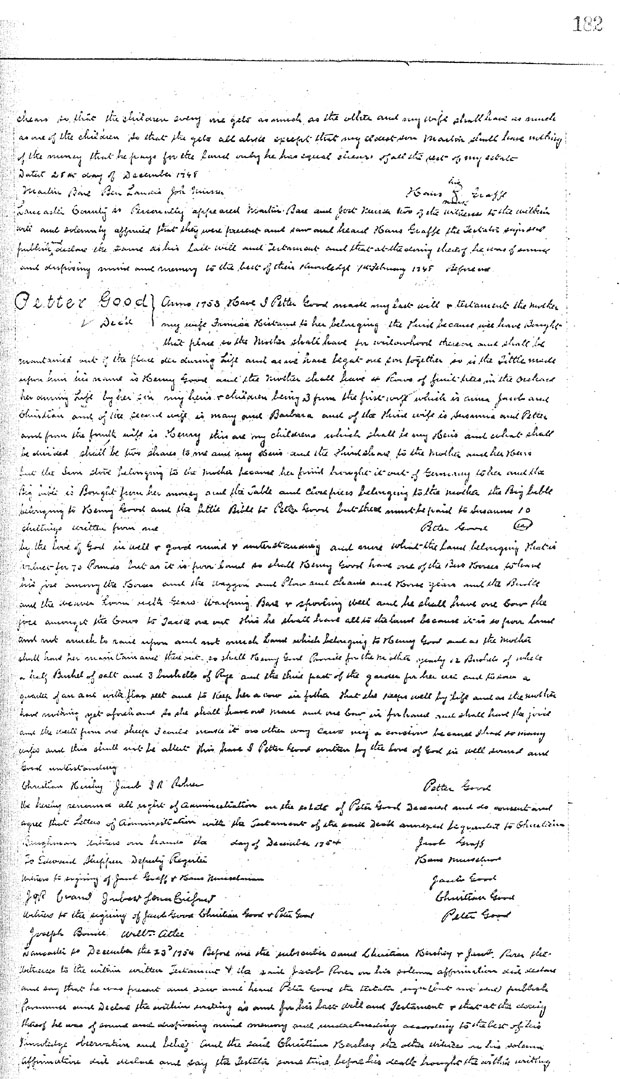
Anno 1753 Have I Petter Good made my last will and testament, the mother my wife Fronica Hiestand to her belonging the third, because wee have bought that place so the mother shall have for widowhood thereon, and shall be maintained out of the place der during life, and as we have begat one son together, so is the tittle made upon him, his name is Henry Good, and the mother shall have 4 rows of fruit trees in the orchard her during life by her son, my heirs and children being 3 from my first wife, which is Anna, Jacob and Christian, and of the second wife is Mary [corrected to Nancy, deceased by 1753] and Barbara, and of the third wife is Susanna and Petter, and from the fourth wife is Henry, this are my children which shall be my heirs, and what shall be divided shall be two shares to me and my heirs, and the third share to the mother and her heirs, but the iron stove belonging to the mother because her frind brought it out of Germany to her, and the big bible is bought from her money, and the table and close press belonging to the mother, the big bible belonging to Henry Good and the little bible to Petter Good, but there must be paid to Susanna 10 shillings written for me. Petter Good (Seal) by the love of God in well and good mind and understanding, and
what the land belonging that is valuet for 70 pounds, but as it is land so shall Henry Good have one of the best horses, to have his among the horses, and the waggon and plow and chains and horse gears and the bridle and the weaver loom with gears warping bare and spooling weel, and he shall have one cow, the amongst the cows to tacke one out. This he shall have all the land because it is so poor land, and not much to raise upon, and not much land which belonging to Henry Good, and as the mother shall have her maintainance there out, so shall Henry Good provide for the mother yearly bushels of whete, a half bushel of salt and three bushels of rye, and the third part of the garden for her use, and to sow a quarter of an acre with flax seet, and to keep har a cow in that she keeps well by life, and as the mother have nothing yet [sic] and so she shall have one mare and one cow in for hand (or house) and shall have the joice and the wull from one sheep. I could make it no other way cause my a consions [sic] because I had so many wives and this shall not be altert. This have I Petter Good written by the love of God in well sound and good understanding.
Petter Good"
Research Notes:
The speculative lineage reported here, back through 1) Peter Gut of Immelhauserhof, Germany, 2) Peter Gut of Michelfeld, Germany, 3) Antoni Gut of Switzerland, 4) Valentine Gutt of Birmensdorf, Switzerland, and 5) Andreas Gutt of Ottenbach, Switzerland, is based on [62] [63]
Most sources about this Peter Good (GC) are consistent with this summary. Peter Good had 4 wives and 8 children; three children by the first wife: Anna, Jacob, and Christian; two by his second wife: Mary and Barbara; two by Anna Graf: Susanna and Peter; and one by Veronica Hiestand: Henry. His third wife Anna Graff died between 1738 and 1740 and was daughter of Hans Graf of Earl Twp. According to a deed, Peter married Veronica, the widow of Hans Schneider (John Taylor?) of Hempfield Twp before 1745. He married Veronica Hiestand, the widow of John Taylor in about 1740 and named her in his will. Peter's two oldest children and their spouses were left in Germany in 1727 and came over in 1732 on the ship Samuel.
Phyllis Fulk and Lois Brown Miller, The Beery Family of Page County, Iowa, (Evans Press, Newport, Arkansas, 1976), Page 15, 4.1; Page 25, 4.4, Husband of (1), Elizabeth Stoner/Steiner; and, (2) Frances Grow. (3) Refus E. Good, Descendants of Jacob Good, (April 1987), Page 1, ID no. 3, Source lists Jacob's first wife (in 1792) as Veronica, 5 sons and 1 daughter; and, his second wife as Unnamed, 4 sons and 1 daughter. Jacob Good (ID no. 3) was the brother of Peter Good (ID no, 2), and the son of Jacob Good (ID no. 1) and Susannah.
Marvin Brubaker has studied some of the descendants of Peter Good. [68]
There was another man named Peter Good in Lancaster County during this time period. The other Peter Good was a tailor who immigrated in 1717 and had a wife Margaret and eldest son Jacob, as implied by a deed dated 1741. Peter, tailor, died in 1745. [72] More information about this other Peter Good can be found in our notes for Peter Good, the possible father of the Peter Good of the notes above.
1741 "Peter Good (formerly of the Palatine Germany but for these twenty four years last past he hath lived and resided in the Province of Pennsylvania) Taylor and Margaret his wife of the one part and Jacob Good of Lancaster County in the said Province Yeoman (son of the said Peter Good born in Pennsylvania) of the other part … for five shillings lawful money … and natural love and affection which they bear him … " sold land by Pequea Creek. [73]
A letter to Hermanus Schijn in Amsterdam from Jacob Schnebli identifies ten groups with a total of 45 people who are prepared to emigrate from Manheim. Peter Gudt heads a group of seven, and Samuel Gudt heads a group of two. This group of 45 travels together all the way to Philadelphia. This letter was cited at the website of Donald Good. It might be cited by the following:
C Henry Smith, The Mennonite immigration to Pennsylvania in the 18th century (1929), pages 33-34 [74]
Richard Kerwin MacMaster, Land, piety, peoplehood : the establishment of Mennonite communities in America, 1683-1790, page 293 [75]
9. Benedikt Brechbuhl, Hans Rudolph Nagele, Ulrich Stauffer, Hans Jacob Schnebeli, and Ulrich Meier to Abraham Jacobsz Fries and Hermanus Schijn, February 6, 1714. #1439, … Dutch Papers; #1374, Dutch Papers, transcript at LMHS; Smith, Mennonite Immigration, 33-34.
[1] Jane Evans Best, "Six Good Families of Early Lancaster County, Pennsylvania," Pennsylvania Mennonite Heritage 12 (July, 1989), 11-28, at 18, (GC).
[2] Jane Evans Best, "Six Good Families of Early Lancaster County, Pennsylvania," Pennsylvania Mennonite Heritage 12 (July, 1989), 11-28, at 26, Peter Good (GC).
[3] Wolf, Krauth, Der Pfinz und Enz Kreis im Grossherzogthum Baden (c 1813), [Old Maps Online Catalog].
[4] Lancaster Mennonite Historical Society, Genealogical Card File (Lancaster, Pennsylvania), The deeds cited refer to a different Peter Good, tailor, [AncestryRecord].
[5] Lancaster Mennonite Historical Society, Genealogical Card File (Lancaster, Pennsylvania), [AncestryRecord].
[6] Lancaster Mennonite Historical Society, Genealogical Card File (Lancaster, Pennsylvania), The deeds cited refer to a different Peter Good, tailor, [AncestryRecord], [AncestryImage].
[7] Lancaster Mennonite Historical Society, Genealogical Card File (Lancaster, Pennsylvania), The deeds cited refer to a different Peter Good, tailor, [AncestryRecord], [AncestryImage].
[9] David L. Good, "One Family's Winding Search for the 'Right' Ancestor," Pennsylvania Mennonite Heritage 44:1 (2021), 15-23, at 16.
[11] Roy Gardner, Noel Gaston, Robert T. Masson, Tolling the Rhine in 1254: Complementary Monopoly Revisited (Bloomington, IA: Indiana University, 2002 Aug), [URL].
[12] Cornelis Boumeester, View of Rotterdam, A tile painting, composed of 33 Delft tiles. (about 1700–20, Courtesy of the Museum of Fine Arts, Boston), [MFA], [MFA terms of use].
[13] Memorial Against Non-English Immigration (1727), [URL].
[14] Courtesy of Library Company of Philadelphia, [URL].
[15] John B. Linn and William Henry Egle, Pennsylvania Archives, Second Series, Volume 17. (Oath of Allegiance 1727-1775) (1890), 9, bottom left, [HathiTrust], [GoogleBooks], [InternetArchive].
[16] Ralph B. Strassburger, William J. Hinke, ed., Pennsylvania German Pioneers, Vol. 1 (1934, Pennsylvania German Society), 13, upper left, Petter Good, [HathiTrust], [InternetArchive].
[17] I. Daniel Rupp, A Collection of Upwards of Thirty Thousand Names of German, Swiss, Dutch, French and other Immigrants in Pennsylvania from 1727 to 1776, 2nd ed. (1875), 52, middle left, Peter Gut, [GoogleBooks], [HathiTrust].
[18] Ralph B. Strassburger, William J. Hinke, ed., Pennsylvania German Pioneers, Vol. 1 (1934, Pennsylvania German Society), 14, upper right, Peder Gut, [HathiTrust], [InternetArchive].
[19] Ralph B. Strassburger, William J. Hinke, ed., Pennsylvania German Pioneers, Vol. 2 (1934, Pennsylvania German Society), 3, middle left, signatures Peder Gut, Samuel Gut, [HathiTrust].
[20] David L. Good, "One Family's Winding Search for the 'Right' Ancestor," Pennsylvania Mennonite Heritage 44:1 (2021), 15-23, at 16.
[21] Barbara L. Weir and Laurie A. Roffini, "German Qualification for Naturalization in Pennsylvania, 1728," Pennsylvania Genealogical Magazine 37 (1991), 367-373, at 369, [AmericanAncestors].
[22] Marion F. Egge, Pennsylvania German Roots Across the Ocean (2000), 35, [GoogleBooks].
[23] Janet and Robert Wolfe, Genealogy Page for Wendel Bowman, political activist, [JRWolfeGenealogy].
[24] The Library Company of Philadelphia, [URL].
[25] Library of Congress, [URL].
[26] Thomas Kitchin, A map of the province of Pensilvania (London: 1756), [LibraryOfCongress Map].
[27] Pennsylvania Land Warrant, Lancaster County, G-32, [PHMC Warrant].
[28] Bureau of Land Records, Pennsylvania Land Patent Books, A9-78, [FamilySearchImage], [FHLCatalog].
[29] Pennsylvania Archives Land Office Survey, A-76-292, [PA Survey Map], [PASurveyBooksIndex].
[30] Pennsylvania Archives Land Office Survey, D82-47, dated 1721, [PA Survey Map], [PASurveyBooksIndex].
[31] Pennsylvania Archives Land Office Survey, C105-269, dated 1738, [PA Survey Map], [PASurveyBooksIndex].
[32] Pennsylvania Archives Land Office Survey, D82-41, [PA Survey Map], [PASurveyBooksIndex].
[33] Pennsylvania Archives Land Office Survey, A-76-286, dated 1743, [PA Survey Map], [PASurveyBooksIndex].
[34] Pennsylvania Archives, Township Connected Warrant Map (large download), [PAConnectedWarrantMaps].
[35] Pennsylvania Archives, Township Connected Warrant Map (large download), [PAConnectedWarrantMaps].
[36] Bureau of Land Records, Pennsylvania Land Patent Books, A9-78, [FamilySearchImage], [FHLCatalog].
[37] Lancaster County, Pennsylvania, Deed B-184, [FamilySearchImage], [FHLCatalog].
[38] Franklin Ellis and Samuel Evans, History of Lancaster County, Pennsylvania with Biographical Sketches (1883), 673, The letter of Tobias has quotes from this book, [GoogleBooks], [HathiTrust].
[39] USGenWeb, Lancaster County, Pennsylvania Will Abstracts (Gateway website), A-26, [USGenWeb].
[40] M. S. Giuseppi, ed., Naturalizations of foreign Protestants in the American and West Indian colonies, (1921), 26, [HathiTrust].
[41] download The Pennsylvania Dutchman, Vol. III, No 11. November 1, 1951, [URL].
[42] Clyde L. Groff, Walter B. Groff, and Jane Evans Best, The Groff Book, A good life in a new land, Vol. 1 (Ronks, Pennsylvania: Groff History Associates, 1997), 41, [FHLCatalog].
[43] Recorder of Deeds, Lancaster County, Pennsylvania, Deed Book C, 322-326, [322], [323], [324], [325], [326], [FHLCatalog].
[44] Pennsylvania Land Patent, A9-78, [PAPatentBookLinks].
[45] Ralph B. Strassburger, William J. Hinke, ed., Pennsylvania German Pioneers, Vol. 1 (1934, Pennsylvania German Society), 60, [HathiTrust], [InternetArchive].
[46] Lancaster County, Pennsylvania, Deed Y1-164, this is the wrong deed, apparently, [FamilySearchImage], [FHLCatalog].
[47] Lancaster County, Pennsylvania Tax Records, 1751, [FamilySearchImage], [FHLCatalog].
[48] Lancaster County, Pennsylvania tax list, 8, [FamilySearchImage], [FHLCatalog].
[49] Lancaster County, Pennsylvania Tax Records, 1756, right side, [FamilySearchImage], [FHLCatalog].
[50] Lancaster County, Pennsylvania Tax Records, 1756, middle left, [FamilySearchImage], [FHLCatalog].
[51] Lancaster County, Pennsylvania Tax Records, 1757, column 2, 4 from bottom, [FamilySearchImage], [FHLCatalog].
[52] Lancaster County, Pennsylvania Tax Records, 1757, left, 7 down, [FamilySearchImage], [FHLCatalog].
[53] Lancaster County, Pennsylvania Tax Records, 1758, [FamilySearchImage], [FHLCatalog].
[54] Lancaster County, Pennsylvania Tax Records, 1758, [FamilySearchImage], [FHLCatalog].
[55] Lancaster County, Pennsylvania Tax Records, 1758, no land, [FamilySearchImage], [FHLCatalog].
[56] Lancaster County, Pennsylvania Tax Records, 1759, Peter Good weaver, Jacob Sigrist tenant, 200 acres, [FamilySearchImage], [FHLCatalog].
[57] Lancaster County, Pennsylvania, Probate Records, A-104, [FamilySearchImage].
[58] USGenWeb, Lancaster County, Pennsylvania Will Abstracts, Y2-182 abstract, not at familysearch, but see the translation below, [USGenWeb].
[59] Pennsylvania, Will and Probate Records, B-69, Index, [AncestryRecord].
[60] Lancaster County, Pennsylvania, Probate Records, B-69, [FamilySearchImage].
[61] From guthguttgood.com.
[62] Jane Evans Best and Howard C. Francis, "Guth Families of Ottenbach, Switzerland, Part II," Mennonite Family History 9 (1990), 22-27, at 27.
[63] Herbert Good, ed., Good/Gut/Guth Newsletter, #10.
[64] Jane Evans Best, "Six Good Families of Early Lancaster County, Pennsylvania," Pennsylvania Mennonite Heritage 12 (July, 1989), 11-28, at 20, GC22.
[65] Ira D. Landis, "Our Good Brethren," Mennonite Research Journal 1 (1960), 11-12, at 11.
[66] Herbert Good, ed., Good/Gut/Guth Newsletter, #31.
[67] Herbert Good, ed., Good/Gut/Guth Newsletter, #33.
[68] Marvin Brubaker, Good family, person 2, [FHLCatalog].
[69] Richard Warren Davis, Mennosearch.com Family Notes, Good D1, [Website].
[70] Jane Evans Best, "Six Good Families of Early Lancaster County, Pennsylvania," Pennsylvania Mennonite Heritage 12 (July, 1989), 11-28, at 19, GC.
[71] Barbara Jean Hiestand Moore, Hiestand Family History: 1400, 1900, Switzerland, Germany, America : Bretz, Brumbach, Flender, Kemper, Mumma, Weber (1990), 34, [GoogleBooks].
[72] David L. Good, "One Family's Winding Search for the 'Right' Ancestor," Pennsylvania Mennonite Heritage 44:1 (2021), 15-23, at 16.
[73] Lancaster County, Pennsylvania, Deed D-222 to 223, [FamilySearchImage], [FHLCatalog].